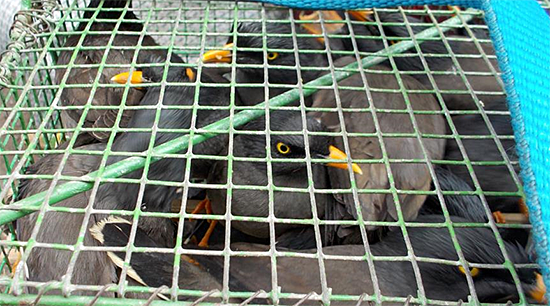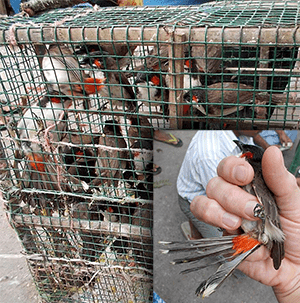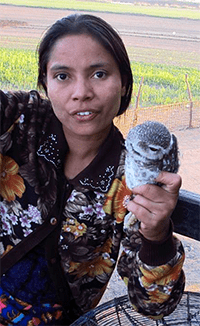A Look at the Unlucky Practice of “Luck Birds” in Burma
By Greg Delisle , Cornell Lab webmaster March 27, 2014
It was on Anawrahta Road, in the Botataung district of Yangon, a stone’s throw from Sri Devi Temple, where I bought my luck bird. It was a Red-whiskered Bulbul, black and white with bright streaks of red on its face, jittery and fluttering inside a boxy cage of bamboo and wire with 20 of its brothers. We had just left the Lucky Seven Teahouse and it was morning, an auspicious time. I paid 1,500 kyats to the bird seller, and he gingerly fished out one of the darting, chirping birds and placed it in my hand.

Curling my fingers into a loose cage around the bird, I turned it this way and that, taking pictures. Then I leaned close and whispered the traditional Burmese benediction, “Today I give you your life, someday you will give me my life.” I spread my hands and the bulbul flitted to a nearby tree, where it twittered excitedly back to its friends still in the cage on the sidewalk. I felt good at the time.
It was my third day in Burma, and my second encounter with the sa-gele khaley, the luck birds. On my first day in the city, walking through a busy street market, I had seen a banana farmer with a blue wire cage stuffed with live mynas (top image). I asked my Burmese host about it, thinking the birds were pets, or food.
“People release them, for luck,” Margarette explained. “It is a Buddhist practice. They get merit, for saving a life.” As a Buddhist myself, I’d heard of the practice of “life release”—sparing animals bound for slaughter—but I had never done it myself. In Burma, the practice allows some country people another source of income. With the help of a monofilament fishnet and a wire basket, they can sit near a pagoda and wait for a wedding procession, a birthday celebration, or just a passing tourist who wants to bless the occasion. An hour after I released my bulbul, I spotted a flock of Baya Weavers rising in a tight group from street level to above the rooftops, and away across the city. I recalled a cage full of weavers on the curb, next to the bulbuls.
In Amarapura, an ancient city near Mandalay, two weeks later, I saw bird sellers again at the east end of U Bein’s Bridge. This century-old teak footbridge is the world’s longest, nearly a mile from end to end, and the only way across Taungthaman Lake. Thousands cross each day, especially at sunset, and local monks approach foreigners to practice their English.

The bird sellers were three sisters, and one clutched a Spotted Owlet by its feet, holding it out toward me. By her seat on a bench at the edge of the bridge were half a dozen more owlets, cowering in their cage. Another cage held 20 swallows, another half a dozen wagtails, and another had an assortment of mynas, ducks, and a pond-heron all crammed in together. A small wooden crate held two Barn Owls, at least one of which was dead. The youngest sister dangled a small wire basket with an eagle inside, its secondary feathers ruffled and broken from its attempts to escape. It was a stark reminder that this was not the pet trade, where birds would be held with food, water, and space to move around. An image of the Baya Weavers, streaking toward freedom, flashed through my mind, and the lone Red-whiskered Bulbul chirping from its tree.
The sisters’ hands fluttered over the cages, pointing. A swallow or wagtail was just 1,000 kyats—about a dollar—and the ducks, owls, or heron were 3,000. They wanted 5,000 for the eagle. My hand went to my wallet, where I had at least 100,000 kyats, enough to buy their entire collection, but I looked hard at the Barn Owls again. It was too late for them. Could the eagle even fly? I began to feel sick.
The impact of this catch-and-release trade is hard to measure. The catchers are typically farmers and fishermen looking for a little more income, or a few more ounces of meat on the table. Well over a thousand bird species are found in Burma, and more than fifty are globally threatened. Where bird populations are robust, the damage may be slight, but studies have shown that shorebird hunting in Burma—for food as well as live release—is a grave threat to the critically endangered Spoon-billed Sandpiper. International efforts to save this single species have focused on reducing hunting and replacing it with small grants to fishermen.
Scientists and conservationists elsewhere in Southeast Asia, along with Buddhist groups, are exploring ways to change the practice of catching luck birds to reduce its environmental impact. Here in the U.S., some Buddhist groups have come up with a remarkably creative way to redirect the tradition toward conservation and wildlife rehabilitation.
That evening on U Bein’s Bridge, I walked on. I watched the sun set over Taungthaman Lake; I chatted with monks; I marveled at the beauty of this land and the resourcefulness of its people; I watched marsh harriers and herons flying low and slow over the water. And I saw clearly that paying those sisters to release those birds, even if the birds had been healthy and lived free the rest of their days, would have meant a big reward for those who caught them, caged them, starved them, and tortured them. And that would have given those sisters, and others like them, a bit more reason to do it again, to other birds on other days. I walked on, feeling lucky just to be there, even without a luck bird to set free.

All About Birds
is a free resource
Available for everyone,
funded by donors like you
American Kestrel by Blair Dudeck / Macaulay Library
